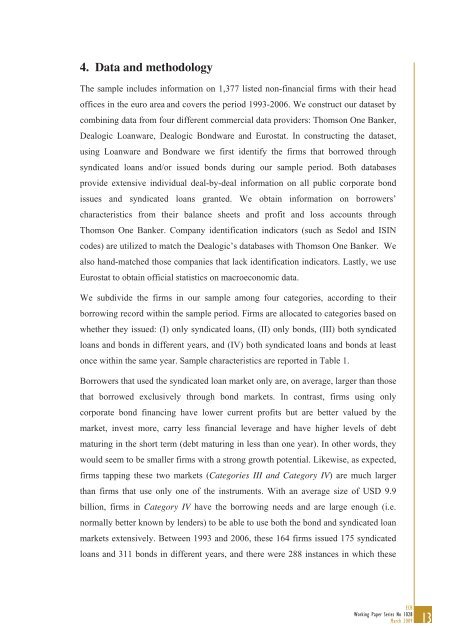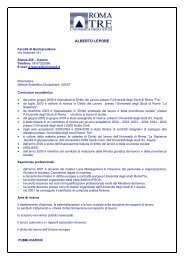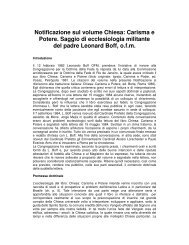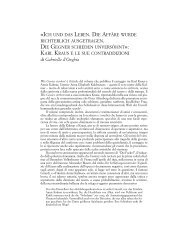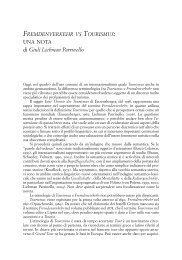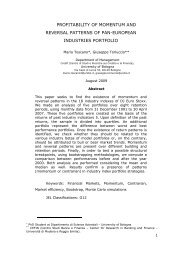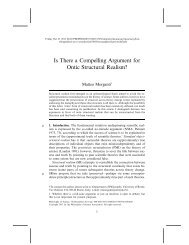large debt financing syndicated loans versus corporate bonds
large debt financing syndicated loans versus corporate bonds
large debt financing syndicated loans versus corporate bonds
Create successful ePaper yourself
Turn your PDF publications into a flip-book with our unique Google optimized e-Paper software.
4. Data and methodology<br />
The sample includes information on 1,377 listed non-financial firms with their head<br />
offices in the euro area and covers the period 1993-2006. We construct our dataset by<br />
combining data from four different commercial data providers: Thomson One Banker,<br />
Dealogic Loanware, Dealogic Bondware and Eurostat. In constructing the dataset,<br />
using Loanware and Bondware we first identify the firms that borrowed through<br />
<strong>syndicated</strong> <strong>loans</strong> and/or issued <strong>bonds</strong> during our sample period. Both databases<br />
provide extensive individual deal-by-deal information on all public <strong>corporate</strong> bond<br />
issues and <strong>syndicated</strong> <strong>loans</strong> granted. We obtain information on borrowers’<br />
characteristics from their balance sheets and profit and loss accounts through<br />
Thomson One Banker. Company identification indicators (such as Sedol and ISIN<br />
codes) are utilized to match the Dealogic’s databases with Thomson One Banker. We<br />
also hand-matched those companies that lack identification indicators. Lastly, we use<br />
Eurostat to obtain official statistics on macroeconomic data.<br />
We subdivide the firms in our sample among four categories, according to their<br />
borrowing record within the sample period. Firms are allocated to categories based on<br />
whether they issued: (I) only <strong>syndicated</strong> <strong>loans</strong>, (II) only <strong>bonds</strong>, (III) both <strong>syndicated</strong><br />
<strong>loans</strong> and <strong>bonds</strong> in different years, and (IV) both <strong>syndicated</strong> <strong>loans</strong> and <strong>bonds</strong> at least<br />
once within the same year. Sample characteristics are reported in Table 1.<br />
Borrowers that used the <strong>syndicated</strong> loan market only are, on average, <strong>large</strong>r than those<br />
that borrowed exclusively through bond markets. In contrast, firms using only<br />
<strong>corporate</strong> bond <strong>financing</strong> have lower current profits but are better valued by the<br />
market, invest more, carry less financial leverage and have higher levels of <strong>debt</strong><br />
maturing in the short term (<strong>debt</strong> maturing in less than one year). In other words, they<br />
would seem to be smaller firms with a strong growth potential. Likewise, as expected,<br />
firms tapping these two markets (Categories III and Category IV) are much <strong>large</strong>r<br />
than firms that use only one of the instruments. With an average size of USD 9.9<br />
billion, firms in Category IV have the borrowing needs and are <strong>large</strong> enough (i.e.<br />
normally better known by lenders) to be able to use both the bond and <strong>syndicated</strong> loan<br />
markets extensively. Between 1993 and 2006, these 164 firms issued 175 <strong>syndicated</strong><br />
<strong>loans</strong> and 311 <strong>bonds</strong> in different years, and there were 288 instances in which these<br />
ECB<br />
Working Paper Series No 1028<br />
March 2009<br />
13


